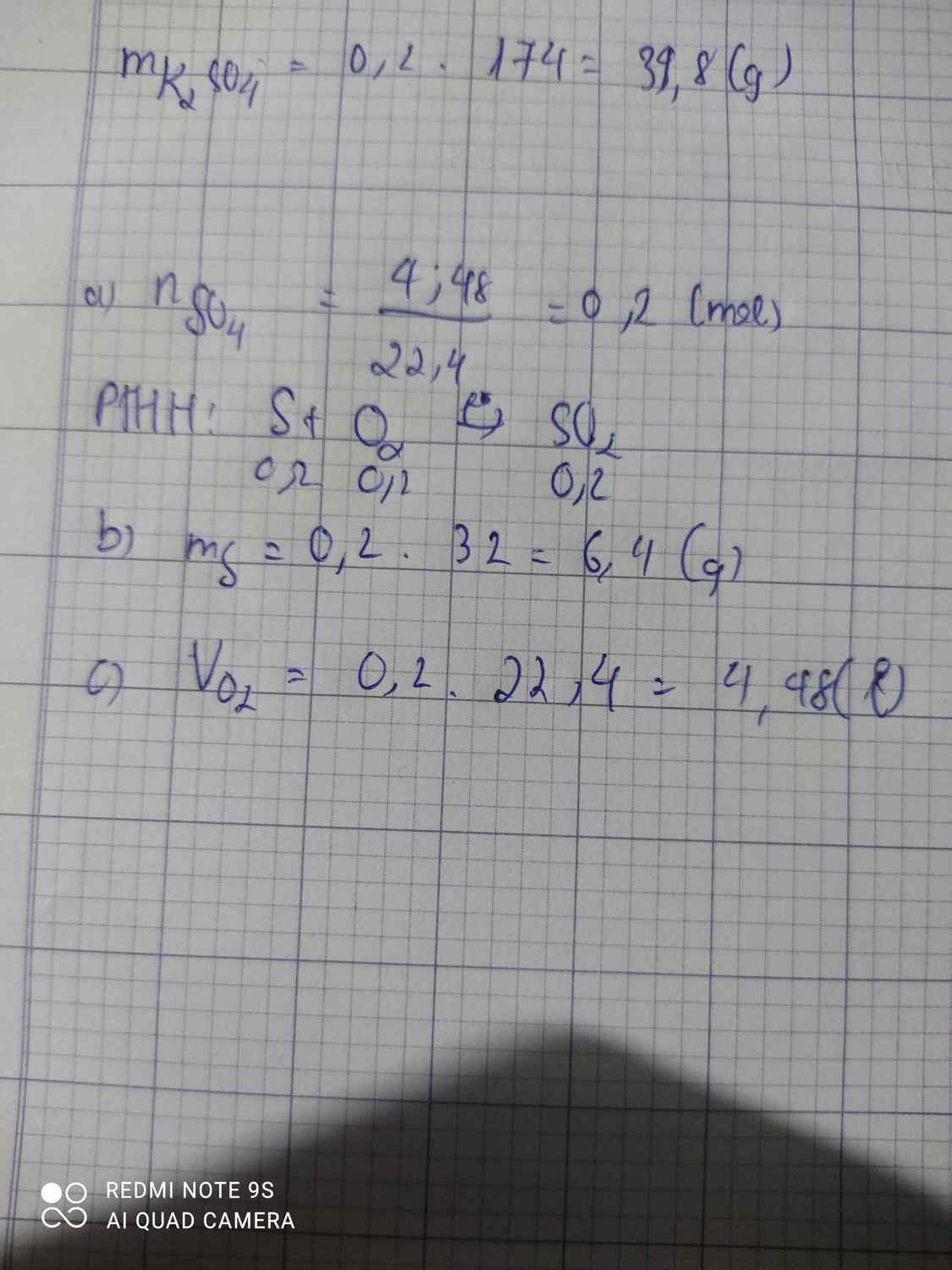Hãy nhập câu hỏi của bạn vào đây, nếu là tài khoản VIP, bạn sẽ được ưu tiên trả lời.

S + O2 →SO2
a) nO2 = 2,24/22,4 = 0,1 mol
=> nSO2 = 0,1 mol
<=> V SO2 = 0,1 .22,4 = 2,24 lít
b) nS = O2 = 0,1 mol
=> mS = 0,1.32 = 3,2 gam
S + O2 →SO2
a) nO2 = 2,24/22,4 = 0,1 mol
=> nSO2 = 0,1 mol
<=> V SO2 = 0,1 .22,4 = 2,24 lít
b) nS = O2 = 0,1 mol
=> mS = 0,1.32 = 3,2 gam

S+O2-to>SO2
0,2--0,2----0,2 mol
n SO2=\(\dfrac{4,48}{22,4}\)=0,2 mol
=>m S=0,2.32=6,4g
=>VO2=0,2.22,4=4,48l

a) S + O2 \(\rightarrow\) SO2
b) Tính độ tinh khiết bằng cách lấy lượng lưu huỳnh tinh khiết(tức là lượng lưu huỳnh tham gia phản ứng ) chia cho lượng lưu huỳnh đề bài cho nhân với 100% . Mình giải luôn nhé!
nSO2 = V/22,4 = 2,24/22,4 =0,1(mol)
Theo PT => nS = nSO2 = 0,1(mol)
=> mS(tinh khiết) = n .M = 0,1 x 32 = 3,2(g)
=> độ tinh khiết của mẫu lưu huỳnh đã dùng = mS(tinh khiết) : mS(ĐB) x 100% = 3,2/3,25 x 100% =98,46%
c) Theo PT thấy nO2 = nSO2
mà số mol = nhau dẫn đến thể tích cũng bằng nhau
=> VO2 = VSO2 = 2,24(l)

b: \(S+O_2\rightarrow SO_2\)
\(n_{O_2}=\dfrac{V_{O_2}}{22.4}=\dfrac{5.6}{22.4}=0.25\left(mol\right)\)
\(\Leftrightarrow n_{SO_2}=0.25\left(mol\right)\)
\(V=0.25\cdot n=0.25\cdot64=16\left(lít\right)\)
\(a.PTHH:S+O_2\underrightarrow{t^o}SO_2\\ n_{O_2}=\dfrac{5,6}{22,4}=0,25\left(mol\right)\)
Từ PTHH trên ta có:
Đốt hết 1 mol S thì cần 1 mol \(O_2\)
=> Đốt hết 0,25 mol S thì cần 0,25 mol \(O_2\)
\(\Rightarrow m_S=32.0,25=8\left(g\right)\)
b. Từ PTHH trên ta có
Đốt 1 mol \(O_2\) thì sinh ra 1 mol \(SO_2\)
=> Đốt 0,25 mol \(O_2\) thì sinh ra 0,25 mol \(SO_2\)
\(\Rightarrow V_{SO_2}=22,4.0,25=5,6\left(mol\right)\)

a) \(n_S=\dfrac{16}{32}=0,5\left(mol\right)\)
PTHH: S + O2 --to--> SO2
0,5->0,5------>0,5
=> mSO2 = 0,5.64 = 32 (g)
b) VO2 = 0,5.22,4 = 11,2 (l)
=> Vkk = 11,2.5 = 56 (l)
c)
\(n_{O_2}=\dfrac{24}{32}=0,75\left(mol\right)\)
Xét tỉ lệ: \(\dfrac{0,5}{1}< \dfrac{0,75}{1}\)
=> S hết, O2 dư
PTHH: S + O2 --to--> SO2
0,5->0,5------>0,5
=> nO2(dư) = 0,75 - 0,5 = 0,25 (mol)

\(n_{O2}=\dfrac{3,36}{22,4}=0,15\left(mol\right)\)
Pt : \(S+O_2\underrightarrow{t^o}SO_2|\)
1 1 1
0,15 0,15 0,15
a) \(n_S=\dfrac{0,15.1}{1}=0,15\left(mol\right)\)
⇒ \(m_S=0,15.32=4,8\left(g\right)\)
b) \(n_{SO2}=\dfrac{0,15.1}{1}=0,15\left(mol\right)\)
\(V_{SO2\left(dktc\right)}=0,15.22,4=3,36\left(l\right)\)
Chúc bạn học tốt

\(n_{SO_2}=\dfrac{2.24}{22.4}=0.1\left(mol\right)\)
\(S+O_2\underrightarrow{^{t^0}}SO_2\)
\(n_S=0.1\left(mol\right)\)
\(m_S=0.1\cdot32=3.2\left(g\right)\)
=> A
PTHH : S + O2 -> SO2
nSO2 = V/22,4= 0,1 mol
Theo PTHH : nS = nSO2 = 0,1 mol
=> mS = n.M = 3,2 g

PTHH : \(S+O_2\left(t^o\right)->SO_2\) (1)
\(SO_2+H_2O->H_2SO_3\) (2)
\(n_{SO_2}=\dfrac{V_{đktc}}{22,4}=\dfrac{1,12}{22,4}=0,05\left(mol\right)\)
Từ (1) -> \(n_S=n_{SO_2}=0,05\left(mol\right)\)
-> \(m_S=n.M=1,6\left(g\right)\)
Từ (2) -> \(n_{H_2SO_3}=n_{SO_2}=0,05\left(mol\right)\)
-> \(m_{H_2SO_3}=n.M=0,05.\left(2+32+16.3\right)=4,1\left(g\right)\)

bài tập 2
3Fe + 2O2 -\(-^{t^o}->\) Fe3O4 (1)
ADCT n= m/M
\(n_{fe_3O_4}\)= 11,6/ 232= 0,05 mol
Theo pt(1) có
\(\dfrac{n_{O2}}{n_{Fe3O4}}\)=\(\dfrac{2}{1}\)
-> \(n_{O2}\)= 2/1 x \(n_{fe3o4}\)
= 0,1 mol
ADCT V= n x 22,4
Vo2= 0,1 x 22,4
= 2,24 (l)
bài tập 4
OXIT AXIT:
- CO2: Cacbon đi oxit
- N2O: đi ni tơ oxit
- SO3: Lưu huỳnh tri oxit
- CO: cacbon oxit
P2O5: đi photpho penta oxit
NO2: Nitơ đi oxit
OXIT BA ZƠ
- HgO: thủy ngân (II) oxit
- MgO: Magie oxit
- FeO: sắt (II) oxit
- Li2O: liti oxit
-CaO: canxi oxit
- BaO: bari oxit
- Na2O: natri oxit
- Al2O3 : Nhôm oxit
ZnO: kẽm oxit

a, PTHH: S + O2--> SO2
b, Theo PTHH: nS=nSO2= 2,24/22,4 =0,1 mol;
c, tương tự: nO2= 0,1 mol;
--> VO2 cần dùng= 0,1 * 22,4 =2,24 l
a) PTHH: \(S+O_2\rightarrow SO_2\)
b) \(n_{SO_2}=\frac{2,24}{22,4}=0,1\left(mol\right)\)
Theo PTHH: \(n_{SO_2}:n_S=1:1\)
\(\Rightarrow n_{SO_2}=n_S=0,1\left(mol\right)\)
\(\Rightarrow m_S=0,1.32=3,2\left(g\right)\)
c) Theo PTHH: \(n_{SO_2}:n_{O_2}=1:1\)
\(\Rightarrow n_{SO_2}=n_{O_2}=0,1\left(mol\right)\)
\(\Rightarrow V_{O_2\left(đktc\right)}=0,1.22,4=2,24\left(l\right)\)